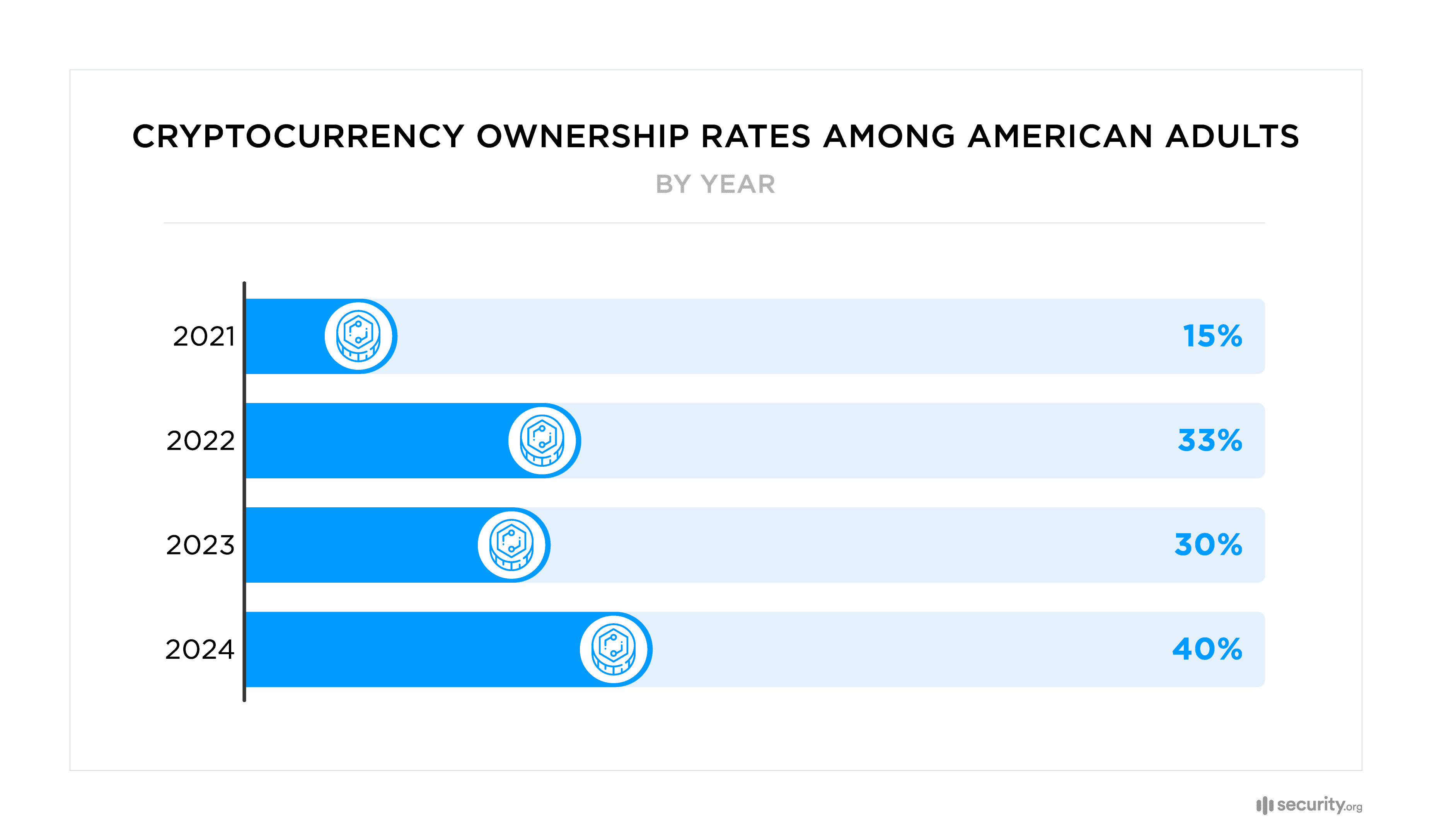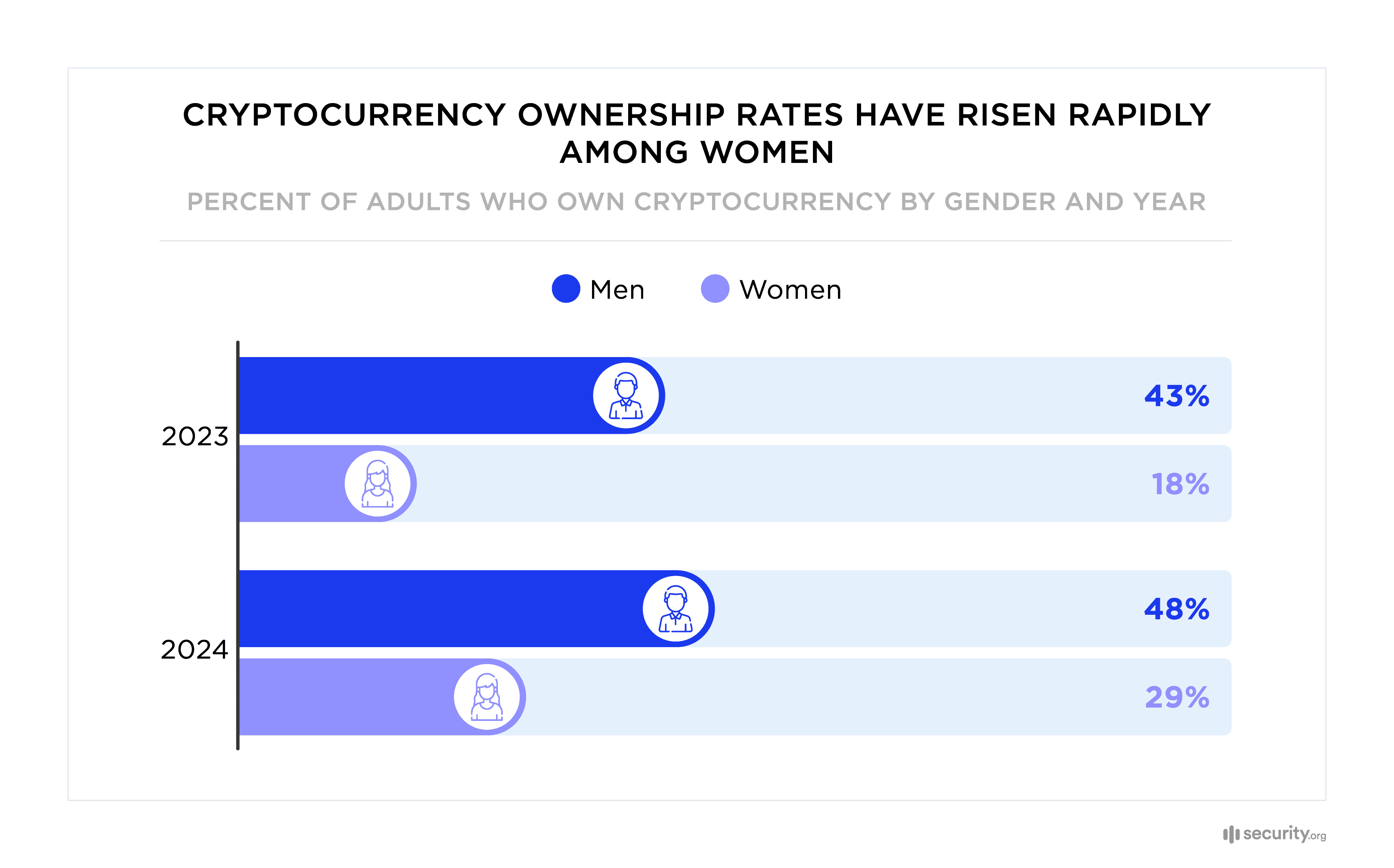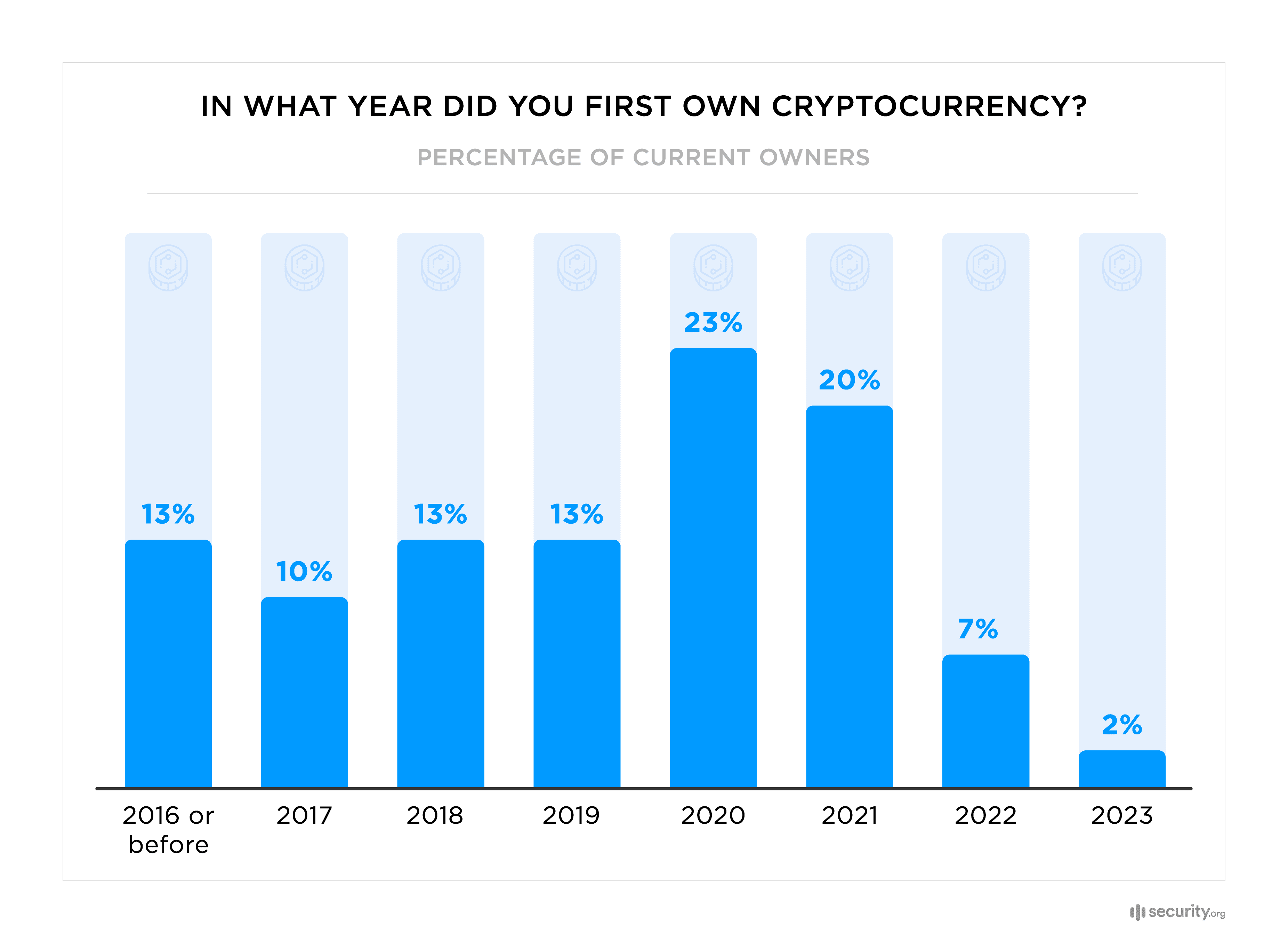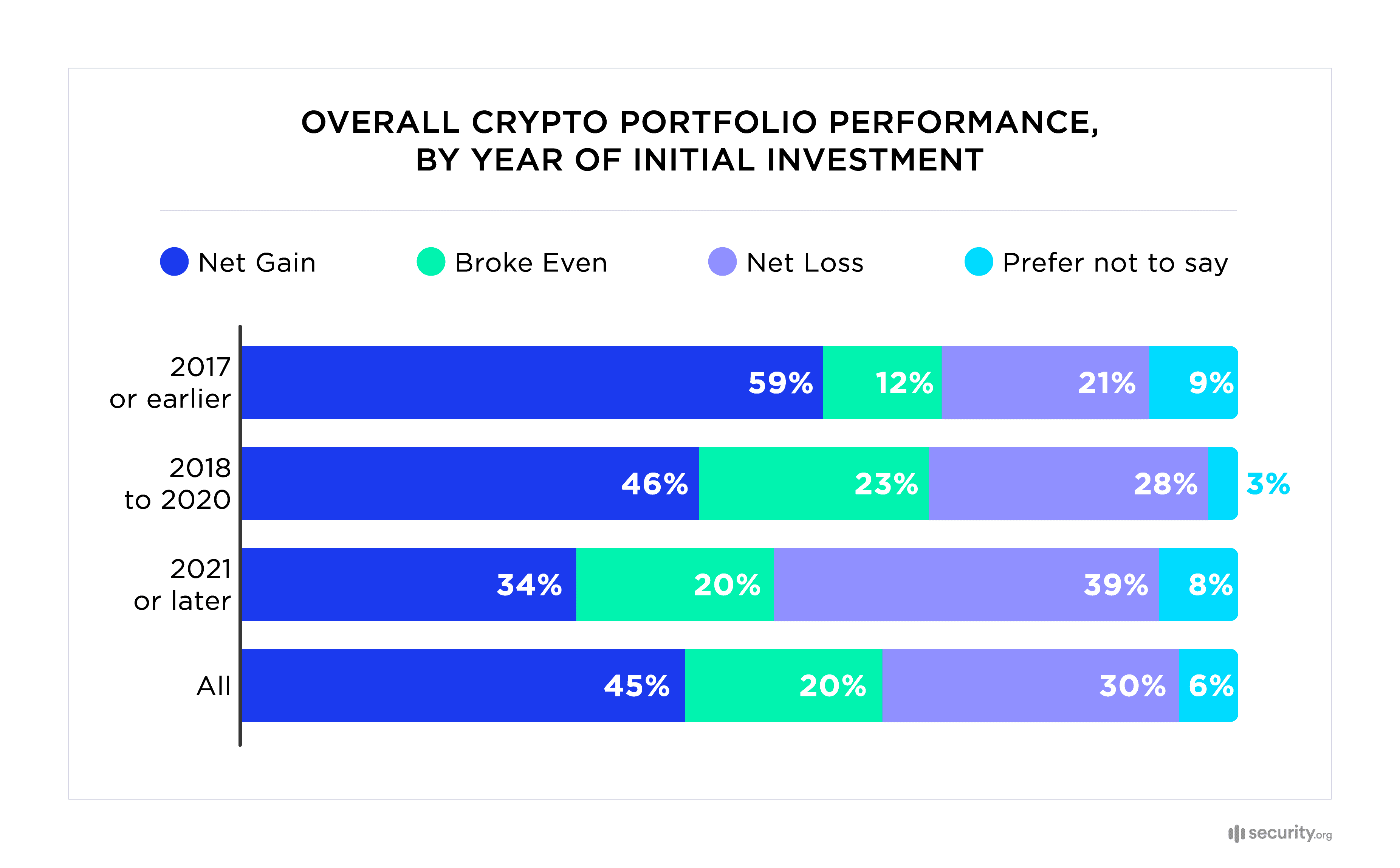2024 Cryptocurrency Adoption and Sentiment Report
The anticipated Bitcoin ETF could drive adoption among crypto holdouts: 21% of non-owners said the ETF would make them more likely to invest in cryptocurrency.
Cryptocurrency markets enjoyed a healthy recovery in 2023 following a tumultuous 2022 bear market that left several cryptocurrency companies insolvent. The recent rally in crypto prices aligns with the multi-year economic cycle centered around Bitcoin’s supply halving. The fourth halving is coming up in April 2024.
Meanwhile, a streak of blockchain industry wins against U.S. regulators in court and growing anticipation that the Securities Exchange Commission (SEC) will approve a Bitcoin ETF early in 2024 have delivered eye-popping returns for many cryptos since October.
Security.org analysts conducted their annual cryptocurrency study for the 4th year as the crypto market recovered. This year’s research includes insights from over 1,500 Americans and gauges consumer sentiment and key factors in cryptocurrency adoption (read our previous reports for 2023, 2022, and 2021).
Key Findings
- Cryptocurrency awareness and ownership rates have increased to record levels: 40% of American adults now own crypto, up from 30% in 2023. This could be as many as 93 million people.
- Among current crypto owners, around 63% hope to obtain more cryptocurrency over the next year. Their most desired currencies were Bitcoin, Ethereum, Dogecoin, and Cardano.
- The rate of crypto ownership by women has surged from 18% a year ago to 29% at the start of 2024.
- 21% of non-owners said the anticipated Bitcoin ETF makes them more likely to invest in cryptocurrency. This means as many as 29 million more Americans could join the market soon.
- 46% of Americans think Bitcoin ETF approvals in 2024 will positively impact the blockchain industry. Those who currently own cryptocurrencies are even more likely to be optimistic.
Cryptocurrency Ownership Rates Have Surged Since 2023
Since conducting our first study in 2021, crypto awareness and ownership have continued to grow. Fewer than half of respondents were aware of cryptocurrency in 2021. But today, more than 80 percent said they were familiar with the financial technology.
Meanwhile, the rate of crypto ownership in the U.S. grew by 10 percentage points in 2023. Adoption is up from 30 percent a year ago to 40 percent today. As a gauge for how many Americans own crypto today, our estimates suggest as many as 93 million people may hold one or more cryptocurrencies.
Men are still much more likely than women to hold crypto. However, there was a significant jump in the crypto ownership rate among women in the past year. This rise could result from the increasing visibility of women covering blockchain developments in the news and investing in cryptocurrency and blockchain companies, such as Unchained Crypto podcast host Laura Shin and Ark Invest founder and CEO Cathie Wood. Thanks to Wood’s big bets on crypto stocks, the hedge fund’s ARK Innovation ETF was 2023’s most profitable ETF. Ark is also one of the SEC applicants for a spot Bitcoin ETF. On the political and regulatory side, there’s pro-crypto Senator Cynthia Lummis (R-WY) and crypto-friendly SEC commissioner Hester Pierce.
Meanwhile, most age groups reported similar ownership rates, except those aged 60+ were significantly less likely to hold cryptos than the younger cohort.
How Might The Bitcoin ETF Change the Crypto Landscape in 2024?
Today, 56 percent of current owners are optimistic that market prices will increase in 2024. If they’re correct, more people may see a net gain by the time of our next study in 2025. Among non-owners, 15 percent intend to purchase crypto this year, up from five percent a year ago.
| Cryptocurrency purchase plans among non-owners (by year) | 2023 | 2024 |
|---|---|---|
| Definitely intend to purchase in next 12 months | 5% | 15% |
| Would consider purchasing in the future | 46% | 41% |
| Will never purchase | 49% | 44% |
Current owners and non-owners who are familiar with cryptocurrencies think that 2024 could be an excellent year for crypto prices. The SEC is evaluating how to approve a spot Bitcoin exchange-traded fund (ETF). An ETF is a security that tracks the price of a single commodity so that people can invest in it on the stock market without directly purchasing it.
After Grayscale sued the SEC for rejecting its Bitcoin ETF application, the District of Columbia Court of Appeals ruled in the hedge fund’s favor in October 2023. The court essentially ordered the SEC to approve the Bitcoin ETF by a January 10, 2024 deadline. Over a dozen other asset managers with pending Bitcoin ETF applications expect theirs to be approved early in 2024.
Interestingly, 39 percent of the general public had heard of this update before participating in our study. Crypto holders, however, were much more aware of the ETF.
The price of Bitcoin soared 28 percent in just two weeks after the ruling, adding some $235 billion in total market value to all cryptocurrencies, according to data from CoinGecko. Galaxy Digital, the crypto hedge fund led by former Goldman Sachs partner Mike Novogratz, expects a Bitcoin ETF to bring $79.5 billion in inflows to Bitcoin in its first three years.
Forty-six percent of the general population think Bitcoin ETF approvals in 2024 will positively impact the blockchain industry. Those who currently own cryptocurrencies are even more likely to be optimistic.
>> Related: Storing Bitcoin Securely
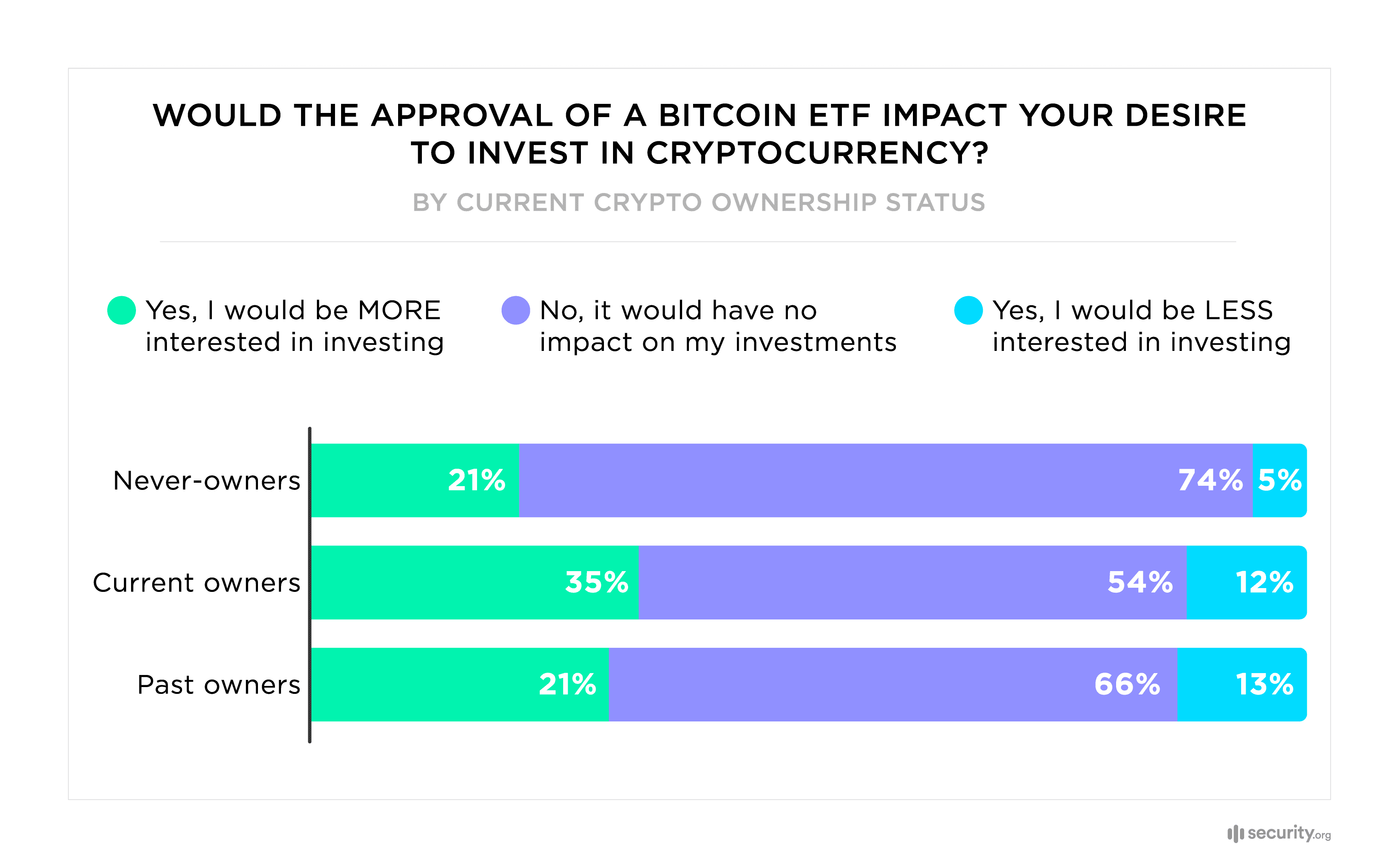
Current crypto owners were most interested in increasing their blockchain investments in anticipation of an ETF approval by the SEC. But even 21 percent of non-owners said this development would make them more interested in buying crypto.
Sixty-three percent of those who have never owned crypto felt that cryptocurrencies should have more government oversight. A regulated Bitcoin ETF may make them feel more confident about investing. By contrast, only 36 percent of owners felt crypto needs more government regulation.
Most Popular Currencies in 2024
Most of our research respondents bought crypto for the first time in 2020 and 2021, but fewer people joined the market since then due to poor performance in 2022. Blockchain adoption gained pace in 2020 and 2021 due to the impressive price performance on crypto exchanges driven by Bitcoin’s third supply halving on May 11, 2020.
Supply halvings are programmed into Bitcoin’s software to occur every four years. As the name implies, the new supply of Bitcoin issued every ten minutes on average is cut in half. The 2020 halving cut new Bitcoin supplies from 12.5 BTC on each new block of transactions down to 6.25 BTC. The 2024 halving will cut new supplies to 3.125 BTC.
Another critical factor in 2020 and 2021 was an investor flight to Bitcoin and other deflationary blockchain currencies to hedge global inflation and geopolitical risk during the pandemic.
As the new supply of Bitcoin fell by 50 percent, the Federal Reserve increased the dollar supply by 20 percent in the first six months of 2020 for emergency monetary stimulus to contain the pandemic recession. As a result of supply and demand, Bitcoin appreciated rapidly against the dollar.
Because Bitcoin is the original cryptocurrency launched in 2009 and maintains over 50 percent of the crypto market share by market capitalization, it remains the center of gravity for the going exchange rates of other cryptos such as Ethereum, Ripple, Dogecoin, and Shiba Inu.
What are the most popular cryptocurrencies in 2024?
Percent of current owners holding various currencies, by year
| Which cryptocurrencies do you currently own? | 2024 | 2023 | 2022 |
|---|---|---|---|
| Bitcoin (BTC) | 76% | 78% | 77% |
| Ethereum (ETH) | 54% | 58% | 65% |
| Dogecoin (DOGE) | 26% | ||
| Shiba Inu (SHIB) | 12% | 18% | 19% |
| Cardano (ADA) | 12% | 14% | 19% |
| U.S. Dollar Coin (USDC) | 12% | 10% | 12% |
| Stellar (XLM) | 12% | 14% | 16% |
| Solana (SOL) | 11% | 10% | 11% |
| Binance Coin (BNB) | 10% | 6% | 6% |
| Ripple (XRP) | 9% | 7% | 6% |
| Tether (USDT) | 7% | 5% | 5% |
| Avalanche (AVAX) | 5% | 6% | 5% |
| Terra (LUNA) | 4% | 2% | 3% |
| Other | 9% |
In our 2024 study, we found the rate of Bitcoin ownership has remained the popular favorite with around three in four crypto owners holding some BTC.
While it remains the second most popular crypto, Ether (ETH) ownership rates have markedly fallen from 65 percent at the end of 2021 to 54 percent as we round out 2023. Because of widespread interest in the Ethereum Merge completed on Sept 15, 2022, to change how Ethereum secures ETH, many crypto adopters saw it as a good year to own Ether.
But competition since then from other smart contract cryptos like Solana (SOL) and Binance Coin (BNB) — plus stubbornly high transaction fees — have led to falling ETH ownership rates.
Meanwhile, we found Ripple (XRP) ownership rates among crypto adopters bumped from seven percent to nine percent throughout 2023 after Ripple Labs prevailed in court against an SEC lawsuit. Despite a significant victory, the suit still hasn’t concluded and goes to trial in April 2024.
Among current crypto owners, around 63 percent hope to obtain more cryptocurrency over the next year. Here are the top currencies they plan to invest in:
- Bitcoin: The supply falls by half this year just as an expected ETF product creates an on-ramp for the mainstream market of regulated investors and piques their interest.
- Ethereum: Crypto consumers anticipate another Ethereum upgrade to boost speed and lower fees while awaiting a spot Ethereum ETF launch by BlackRock, Inc.
- Dogecoin:– DOGE doesn’t have halvings like BTC, but the same industry-leading 256-bit encryption technique secures it.
- Cardano: ADA has been an ETH competitor since adding smart contracts in September 2021. In 2024, the project plans to formalize its governance ideals as smart contract code.
Crypto Portfolio Performance and Public Perception
Among owners, the most popular reason for crypto adoption was to diversify investments. With Bitcoin’s correlation to stocks the most negative since before the pandemic, crypto has generally enjoyed much success as a portfolio diversifier in 2023.
Over a third of owners hold crypto out of sheer interest in the technology. They may understand the economic and financial side of crypto, but they’re also in it for the tech — mathematically advanced software developed in part by security agencies like the NSA.
Meanwhile, 22 percent invested because someone they know recommended it. That’s how billionaire hedge fund manager Steve Cohen came to adopt cryptocurrency. He was a skeptic at first, but after some conversations with his son, Cohen became a cryptocurrency enthusiast.
| What were your reasons for obtaining cryptocurrency? Select up to THREE. | Percentage of current owners |
|---|---|
| As an asset in my portfolio of investments or to diversify investments | 57% |
| I am interested in crypto technology | 36% |
| It is the future | 31% |
| Someone I know encouraged me to try it | 22% |
| I think it’s cool to own crypto | 15% |
| To make purchases online | 13% |
| To protect my money from inflation | 13% |
| To avoid government regulations | 7% |
| To make purchases more privately | 7% |
| Move money to other countries without exchange fees | 3% |
| Gift/free | 1% |
The dominant motivations among cryptocurrency adopters have remained similar over the results from our study one year ago.
As we see above, over half of crypto holders bought cryptocurrencies to boost the profitability of their assets. Today, about 45 percent say they’ve seen a return on their investments. However, 30 percent have experienced net losses from their cryptocurrency purchases.
The earlier people entered the market, the more likely they were to see a return. This shows that crypto is unlikely to help you get rich quickly. However a weekly dollar cost averaged accumulation of Bitcoin from October 2022 to October 2023 would have yielded a modest 13 percent annual return. The same strategy to accumulate an S&P 500 ETF over the same period would have yielded 2.36 percent.
Cryptocurrency Concerns in 2024
Though the idea of a Bitcoin ETF has eased concerns for some holdouts, many crypto owners and non-owners alike still harbor worries. Though people may soon be able to trade Bitcoin much like they would other stocks, nearly two-thirds of people with money managers or financial advisors were still uncomfortable with the idea of investing funds into cryptocurrency.
A December study by investment bank and asset manager Needham & Company found that may be because clients prefer to buy cryptocurrency on a crypto exchange. That would certainly align with the DIY finance ethos of owning and using cryptocurrency. The study found that nearly all advisors expect interest to grow if Bitcoin prices continue to increase.
Despite more people being open to crypto in 2024, 44 percent of non-owners said they would never buy cryptocurrency. The top reasons are unstable values and lack of government protections.
| What is your greatest concern regarding cryptocurrency? | Never-owners | Current owners | Past owners |
|---|---|---|---|
| Unstable value | 40% | 46% | 46% |
| Unprotected by government or bank oversight | 26% | 10% | 13% |
| Difficulty trusting exchanges | 14% | 14% | 13% |
| Cyber attacks | 3% | 11% | 8% |
| Lost access | 3% | 7% | 7% |
| Environmental impact | 7% | 2% | 3% |
| Hard to trade | 3% | 3% | 5% |
| Other reasons | 3% | 2% | 2% |
| Overregulation/bans | 0% | 3% | 0% |
| I have no concerns | 1% | 3% | 2% |
A few non-owners were concerned about attacks by cybercriminals (three percent), but current owners were much more concerned about that possibility (11 percent).
Worries about cryptocurrencies’ unstable values were key concerns for both non-owners and current owners. That’s understandable given that the price of Bitcoin, the most popular and highly-capitalized cryptocurrency, has fallen by more than 50 percent six times in its history.
Cryptocurrencies’ lack of protection from governments or bank oversight concerns more than a quarter of non-owners. Owning blockchain assets comes with several unique risks, such as cyber theft, lost passwords, and costly transaction errors that cannot be reversed.
Few people were concerned about losing access to their funds, but 14 percent of owners have had issues accessing their cryptocurrency. Keeping the private keys to your crypto instead of holding crypto with a custodian such as an exchange or fund makes losing your keys or forgetting a password to access them a potential hazard.
Conclusion
Our previous cryptocurrency adoption and sentiment survey a year ago revealed a crisis of confidence in the industry and a cautious outlook on the cryptocurrency market. These results coincided with market bottom prices after 2022’s crypto winter.
In the years since, cryptocurrency prices have rebounded markedly, with substantial gains for digital asset prices on crypto exchanges from 2023 to 2024. Along with the resurgence in prices for popular cryptos, market outlook, consumer sentiment, and eagerness for adoption surged last year.
The path forward is still fraught with all the risks of an innovative technology sector and a disruptive new industry. Still, cryptocurrency also promises the potential for the kind of rewards investors have come to expect from successful high-tech ventures since the 1990s.
Our data
We conducted two internet-based surveys for this report. The first was a nationally representative study of 1,001 adults in the United States. Their ages, genders, and ethnic backgrounds represented the national population. We also conducted a more detailed poll of 504 people who currently own cryptocurrency to understand their attitudes and decision-making around cryptocurrency better. The two survey populations were unique, and no participant answered both questions.

